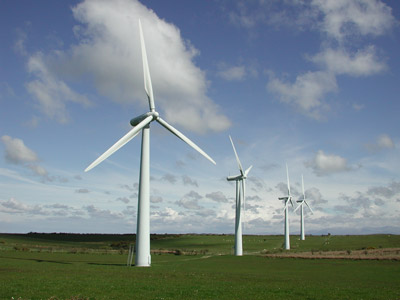- Written by Muthukumaran ECE
- Hits: 6816
New Ideas Enhance Efficiency of Wind Turbines
A milestone in the history of renewable energy occurred in the year 2008 when more new wind-turbine power generation capacity was added in the U.S. than new coal-fired power generation. The costs of producing power with wind turbines continues to drop, but many engineers feel that the overall design of turbines is still far from optimal.

New ideas for enhancing the efficiency of wind turbines are being presented this week at the American Physical Society Division of Fluid Dynamics meeting in Long Beach, CA.
One issue confronting the efficiency of wind energy is the wind itself -- specifically, its changeability. The aerodynamic performance of a wind turbine is best under steady wind flow, and the efficiency of the blades degrades when exposed to conditions such as wind gusts, turbulent flow, upstream turbine wakes, and wind shear.
Now a new type of air-flow technology may soon increase the efficiency of large wind turbines under many different wind conditions.
Syracuse University researchers Guannan Wang, Basman El Hadidi, Jakub Walczak, Mark Glauser and Hiroshi Higuchi are testing new intelligent-systems-based active flow control methods with support from the U.S. Department of Energy through the University of Minnesota Wind Energy Consortium. The approach estimates the flow conditions over the blade surfaces from surface measurements and then feeds this information to an intelligent controller to implement real-time actuation on the blades to control the airflow and increase the overall efficiency of the wind turbine system. The work may also reduce excessive noise and vibration due to flow separation.
Initial simulation results suggest that flow control applied on the outboard side of the blade beyond the half radius could significantly enlarge the overall operational range of the wind turbine with the same rated power output or considerably increase the rated output power for the same level of operational range. The team is also investigating a characteristic airfoil in a new anechoic wind tunnel facility at Syracuse University to determine the airfoil lift and drag characteristics with appropriate flow control while exposed to large-scale flow unsteadiness. In addition, the effects of flow control on the noise spectrum of the wind turbine will be also assessed and measured in the anechoic chamber.
Another problem with wind energy is drag, the resistance felt by the turbine blades as they beat the air. Scientists at the University of Minnesota have been looking at the drag-reduction effect of placing tiny grooves on turbine blades. The grooves are in the form of triangular riblets scored into a coating on the blade surface. They are so shallow (between 40 and 225 microns) that they can't be seen by the human eye -- leaving the blades looking perfectly smooth.
Using wind-tunnel tests of 2.5 megawatt turbine airfoil surfaces (becoming one of the popular industry standards) and computer simulations, they are looking at the efficacies of various groove geometries and angles of attack (how the blades are positioned relative to the air stream).
Riblets like these have been used before, in the sails on sailboats taking part in the last America's Cup regatta and on the Airbus airliner, where they produced a drag reduction of about 6 percent. The design of wind turbine blades was, at first, closely analogous to that of airplane wings. But owing to different engineering concerns, such as turbine blades having a much thicker cross section close to the hub and wind turbines having to cope with peculiar turbulence near the ground, drag reduction won't be quite the same for wind turbines.
University of Minnesota researchers Roger Arndt, Leonardo P. Chamorro and Fotis Sotiropoulos believe that riblets will increase wind turbine efficiency by about 3 percent.



